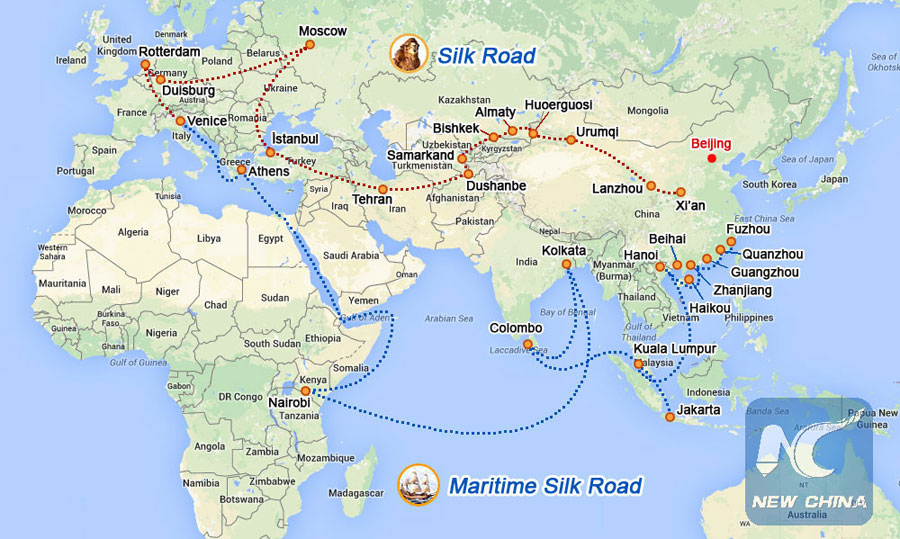 BEIJING, Oct. 12 (Xinhua) — The Belt and Road Initiative unveiled three years ago has already delivered tangible results, contributing to global economic recovery and creating momentum for long-term global economic growth.
BEIJING, Oct. 12 (Xinhua) — The Belt and Road Initiative unveiled three years ago has already delivered tangible results, contributing to global economic recovery and creating momentum for long-term global economic growth.
Proposed by Chinese President Xi Jinping, the initiative refers to the Silk Road Economic Belt that links China with Europe through Central and Western Asia by inland routes, and the 21st Century Maritime Silk Road connecting China with Southeast Asia, Africa and Europe by sea.
The initiative offers both a long-term development vision and real benefits in the near future.
ECONOMIC CORRIDORS
Construction of the very first highway in Mongolia, a landmark project in the country under the Belt and Road Initiative, has been under way since May 2016.
The highway, linking the capital city, Ulan Bator, and the new international airport in Khushigt Valley, Tuv Province, has been hailed by then Mongolian Prime Minister Chimed Saikhanbileg as “a new milestone” in the history of infrastructure in Mongolia.
As a landlocked country, Mongolia shares borders with only two countries: China and Russia. Its ambitious Steppe Road plan, an infrastructure construction proposal to spur economic growth through cross-border transportation, is highly consistent with the Belt and Road Initiative, especially the construction of the China-Mongolia-Russia economic corridor.
The corridor is one of the six major international economic cooperation corridors under the Belt and Road Initiative.
In July 2015, China, Mongolia and Russia signed a memorandum of understanding on the construction of the economic corridor covering their countries.
In September 2016, Beijing released an outline of the plan for the corridor, marking the official implementation of the first outline of the multilateral cooperation plan.
While in Pakistan, infrastructure development is progressing rapidly thanks to the construction of the China-Pakistan economic corridor.
In April 2016, the reconstruction and upgrade work on the Pakistani section of the Karakoram Highway officially started. In May, construction of the Peshawar-Karachi Expressway (Sukkar-Multan section), the biggest transport infrastructure project under the China-Pakistan economic corridor, was officially launched. Meanwhile, a 64 km stretch of the M4 highway connecting Shorkot to Khanewal in Pakistan’s Punjab province broke ground in August. It is Pakistan’s first highway project financed by the China-backed Asian Infrastructure Investment Bank.
The China-Pakistan economic corridor is regarded as the first chapter of the Belt and Road symphony. With the economic corridor at the center and the Gwadar Port, transport infrastructure, energy and industrial cooperation being the four key areas, a “1+4” cooperation structure is gradually taking shape.
Pakistani Prime Minister Nawaz Sharif has said on many occasions that the China-Pakistan economic corridor is a boon to the whole region and it will bring tangible benefits to the 3 billion people in China, Central Asia, South Asia and the Middle East.
MARITIME SILK ROAD CONSTRUCTION
Marking a milestone agreement for China-Greece collaboration, China’s Cosco Shipping on Aug. 10 acquired a majority stake in Piraeus Port Authority through the Athens Stock Exchange.
The port is now ranked 39th globally up from 93rd in 2010 in terms of container capacity, and it can be considered a rising star partly due to its convenient geographic location, thanks to China’s Belt and Road Initiative.
Piraeus is expected to operate as a hub in Europe for the 21st Century Maritime Silk Road, and to connect the Silk Road Economic Belt with the China-Europe Land-Sea Express Line, boosting economic growth in regions that the initiative covers.
Broad achievements have been scored since the 21st Century Maritime Silk Road was proposed by Xi three years ago.
In September, the 13th China-ASEAN Expo was held in China’s Guangxi Zhuang Autonomous Region. The expo, with an aim to promote the 21st Century Maritime Silk Road and forge a closer China-ASEAN community of common destiny, attracted more than 2,600 companies from 29 countries.
China and ASEAN mark the 25th anniversary of their dialogue relations in 2016. Trade between China and ASEAN rose to 472 billion U.S. dollars in 2015 from less than 8 billion dollars in 1991, with an annual growth rate of 18.5 percent.
By the end of May 2016, two-way investment had exceeded 160 billion dollars. Currently, China is ASEAN’s largest trading partner, while ASEAN is the third-largest trading partner of China.
So far, more than 300 China-funded enterprises have been set up in 26 economic cooperation zones in eight ASEAN countries, investing a total of 1.77 billion dollars.
Abhisit Vejjajiva, a former prime minister of Thailand, has said that the Belt and Road Initiative would enhance people-to-people exchanges in countries along the route of the program, and it would also create vital opportunities for Thailand and other nations.

